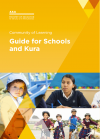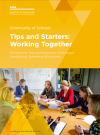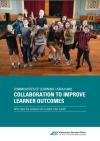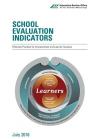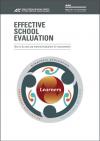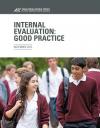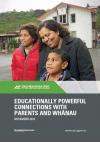Communities of Learning | Kāhui Ako
Communities of Learning are "aimed at making it easier for schools to work together around a child’s journey through the education system to tackle educational challenges, and get the professional resources they need to do that."
– Ministry of Education
A Community of Learning | Kāhui Ako is a group of education and training providers working together to help learners achieve their full potential. These include:
- early childhood education services me ngā kōhanga reo (early learning services)
- schools and kura
- post-secondary.
Each Community of Learning sets shared goals or achievement challenges based on the identified needs of its learners. An action plan is developed to identify how the Community of Learning will achieve its goals.
Community of Learning model
Enlarge Community of Learning model »
The Community of Learning model, developed by NZEI Te Riu Roa and the Ministry of Education, is based on sector research identifying what supports children's learning.
Communities of Learning: What do you need to know
Mark Potter, principal of Berhampore School outlines and expands on the four phases for forming a Community of Learning.
- Forming relationships
- Developing a collective purpose
- Planning for the change you are trying to achieve
- Collective action
He points out that this process takes time and commitment. Time spent building quality relationships supports the success of the community functioning and achieving its goals.
Communities of Learning | Kāhui Ako: Building Relationships
School leaders explain the importance of building relationships within your Community of Learning, this includes outside experts – it is a move from "me and my school to us and our network or community" explains Jill Farquarson, principal of Auckland Normal Intermediate. Taking time to listen to and understand each other's perspectives is an important part of this process.
Communities of Learning | Kāhui Ako: Sharing Best Practice
Principals and lead teachers from Communities of Learning share how they are building positive relationships and sharing best practice so that tamariki can benefit from the collaboration.
Key resources
Community of Learning | Kāhui Ako toolkit
The toolkit, developed by The Ministry of Education, contains information about the tools, resources, and services available to support Communities of Learning | Kāhui Ako to meet their achievement challenges and deliver personalised learning pathways for all ākonga.
The tools are arranged into six domains. Each Kāhui Ako will be at different stages of development in key areas within these six domains. The Development Map is designed to help each Kāhui Ako identify potential future development areas under each domain.
Community of Learning: Guide for schools and kura
This Ministry of Education guide will walk you through what a Community of Learning looks like, what is required to become a Community and how to get started. It also discusses how a Community of Learning will work in practice and explains the available support and advice you may need along the way.
Community of Schools – Tips and starters: Working together
This document is a supplementary document to the Community of Schools Guide for Schools and Kura. It provides tips and starter points on working together: best practices for collaboration, how to approach setting your first achievement challenge, and your Community of Learning structure.
Collaborative practice
Creating a culture of collective responsibility is at the heart of how an effective Community of Learning operates.
Building connections
Creating a collaborative community requires more than just setting up professional networks. The aim is to meet both individual and social needs.
Educational communities that are prepared to “explore new ideas and ways of working, share, and challenge each other’s knowledge, work through open-ended problems, navigate relationships [and] learn about themselves” are more likely to experience transformational outcomes (Bolstad, 2011 p15) . A professional learning community where critical dialogue around learning and transformation carries on over time helps to evolve and strengthen teacher practice. To embed change, a commitment to ongoing learning and change is needed. As teachers embrace new ways of teaching, their pedagogy and practice will shift and impact positively on student outcomes (Taylor, Fagan & Dunmill, 2014 p25 ).
More information »
Collaboration and digital technologies
Digital technologies can be enablers of collaboration for educators through:
- Online communities of practice like social networking sites and discussion forums
- Communication platforms like email and video conferencing
- Shared resources like shared documents and folders
- Common access to student data and resources
This Grass Roots Project Report features a Community of Learning (CoL) made up of five small schools in Lower Mataura Valley (LMV).
Sonya van Schaijik, Newmarket School, explains how TeachMeet works, how she introduced it into New Zealand, and the benefits it provides for teachers to connect and share their practice
Kaikohekohe cluster principals, Tracey Simeon and Lee Whitelaw, explain the keys to successful collaboration. It is a community effort in trying to support every child in the community. Principal, Tracey Simeon comments, "We’ve got an iwi, we’ve got hapū, and we’ve got whānau hapu and this is what a collaboration looks like...and if we look at the schools being the whānau group, you can see that an iwi is stronger than a whānau group so I think it’s about looking beyond your school fence and thinking about how could we best equip our community or our iwi."
Three teachers from Woodend School explain how being part of the Katote cluster has benefited them. The schools in the cluster have collaborated by sharing ideas from their PD and the tools they have implemented in their classrooms.
Schools and organisations may be working alongside each other, and each may be working really hard at what they are trying to achieve, but this parallel work is not creating a community (Taylor, Fagan & Dunmill, 2014 p25 ).
Schools wanting to be future-oriented need to pay particular attention to diversity, connectedness, and coherence (Bolstad et al. 2012 ). Consider how your learning environment works for diversity, not just with diversity. Working for diversity needs a cohesive vision and plan where ideas and people are connected (Taylor, Fagan & Dunmill, 2014 p25 ).
Puketeraki Kāhui Ako – Collaboration in action
Puketeraki Kāhui Ako is a community of learning comprised of nine early childhood centres, 16 primary schools, and one high school. It represents over 6000 students.
This video series features the Lead Principal, Across Schools Teachers, and Within School Teachers sharing successful ways they have built relationships, collaborated, and developed systems to support the development of their Kāhui Ako.
References
Key resources
Communities of Learning | Kāhui Ako: Collaboration to Improve Learner Outcomes
This publication is designed to support Communities of Learning | Kāhui Ako by bringing together research findings about effective collaboration in education communities. It is supported by the publication Communities of Learning | Kāhui Ako: working towards collaborative practice. These resources can be used in conjunction with School Evaluation Indicators: effective practice for improvement and learner success (2016) and Effective School Evaluation: How to do and use internal evaluation for improvement (2016).
Communities of Learning | Kāhui Ako: Working towards collaborative practice
This resource is designed to support Kāhui Ako as they work towards effective collaborative practice. It is framed around key questions in each of the seven effective practice areas and is able to be used both as evidence-based progressions and as a useful internal evaluation tool.
Communities of learning | Kāhui Ako – What's happening across NZ?
- Educational Leaders: Communities of learning – A collection of sabbatical reports and other reflections on what is happening in Kāhui Ako
- Puketeraki Kāhui Ako: Collaboration in action – This video series features the Lead Principal, Across Schools Teachers, and Within School Teachers sharing successful ways they have built relationships, collaborated, and developed systems to support the development of their Kāhui Ako.
Rotorua Central Community of Learning | Kāhui Ako
In June of 2016, a cluster of schools based in Central Rotorua joined forces and became the Rotorua Central Community of Learning (RCCoL).
Rotorua Central Community of Learning consists of nine schools focused on improving student achievement in reading, writing, mathematics, and students achieving NCEA level 2.
More information »
Starting with a theory of improvement
To meet their achievement targets, they worked with Helen Timperley and Lisa Dyson, and Hinemoa Anaru from Ngā Pūmanawa e Waru to develop an action plan based on their theories of improvement.
"A theory for improvement is a set of linked ideas about how to improve valued outcomes."
Components of a theory of improvement
- Definition of the problem the theory is designed to address current understandings of the causes of the problem and how they might interrelate.
- Proposed solutions to address the causes which directly relate to the problem and causes, and which are understood by all involved.
- Rationale for the solutions, including evidence of likely effectiveness to address the particular problem.
- Interim and long-term targets against which progress can be judged including what counts as success in meeting the targets.
- Ways to monitor progress towards the targets
Lai, M., Timperley, H. & McNaughton, S
Theories of improvement have been developed for each of the following key learning areas:
- writing
- reading
- maths
- NCEA 2
- students with additional needs (SWANs)
Rotorua Central Kāhui Ako leader, Nancy Macfarlane explains how their community of learning developed their action plan and strategic framework. Their starting point was developing their theory of improvement. This is underpinned by a comprehensive implementation plan, which breaks down every aspect within their theory of improvement and sets out how it will be achieved. They have a theory of improvement and an implementation plan for each achievement challenge.
Nancy Macfarlane (Kāhui Ako leader) and Hinemoa Anaru (Ngā Pūmanawa e Waru Education Trust) explain how they have used evaluative thinking and developed theories of improvement to provide direction for their Kāhui Ako. Nancy says, “it actually makes you delve in deeper into the measures of success and what that would look like, and how you utilise that to set your next activities or outcomes in your achievements."
Evaluative thinking
Evaluative thinking contributes to new learning by providing evidence to map and monitor progress – successes, barriers, and failures. It involves thinking about:
- what evidence will be useful during the course of innovation activities
- establishing objectives and targets to determine progress
- building knowledge and developing practical uses for the new information throughout the innovation.
Having a continuous cycle of generating hypotheses, collecting evidence, and reflecting on progress enables stakeholders to experiment, try things and review the effects of the innovation.
- Educational innovation – Throughout the innovation process there is constant problem definition, horizon scanning, situation analysis, monitoring of progress, creation of contingency plans, and feedback for improvement.
- Educational evaluation – Systematic collection and analysis of data is needed to make decisions and identify the effects of initiatives. Evaluation frameworks need to consider evidence in the context of the innovation.
Kāhui Ako structure
Within the Rotorua Central Kāhui Ako, there are three "Across Community" teacher positions, each with an area of responsibility:
- Children with additional learning needs (moderate to high).
- Writing, years 5–10.
- Reading, years 1–8.
The "Within School Leader" positions work closely with the "Across Community" leaders to review their spirals of inquiry and what’s happening within their schools linking back to their theories of improvement.
Using the PaCT
Implementation of the PaCT Tool Writing Framework across the Kāhui Ako will improve knowledge and enhance sharing of best practice within and across the schools. The goal is to achieve a common understanding of learning progressions and trust in the assessment data so that student engagement and achievement in years 5–10 in writing will increase.
Rotorua Central Kāhui Ako leader, Nancy Macfarlane explains their staged process for implementing the PaCT for writing, reading, and maths. Nancy says, “Ideally, what we want to have within our CoL structure, is those learner pathways where students and teachers are talking the same language."
References
Lai, M., Timperley, H. & McNaughton, S. (Publication date unknown) Building evaluative capability in schooling improvement – position paper 2: Building evaluative capability through theories for improvement and sustainability.
Hopkins, D. (nd) Theories of action for learning and teaching
Key resources
Community of Learning | Kāhui Ako
The Ministry’s landing page for all resources supporting Communities of Learning | Kāhui Ako.
A five-part framework with questions to support learning communities to review their collaborative practices. This has been developed by CORE Education.
Te Rāngai Kāhui Ako ā-Iwi is a framework to support sustainable Māori medium education, recognising the diversity region by region, iwi by iwi.
Tools and resources to support developing your action plan
Local curriculum design tool | Rapua te ara
This toolkit is for Kāhui Ako, schools, and kura to collaboratively design a quality, local curriculum for their learners. The toolkit is made up of eight tools which support both Māori and English medium education settings. They have been designed to help local curriculum communities facilitate conversations, capture decisions and share their learning. The tools combine to help communities to build a shared local curriculum, focused on supporting children and young people across the education pathway. Factsheet: Personalised pathways for kids through quality teaching in Communities of Learning | Kāhui Ako provides detailed information.
The Inclusive Practices Tools are designed to support primary, intermediate, and secondary schools to engage in a review process. The aim of the review process is to support schools to engage in an ongoing journey toward building inclusive practices for all learners (including learners with extra support needs).
The Wellbeing@School tools are designed to support primary, intermediate and secondary schools to engage in a review process. The W@S self-review tools explore how different layers of school life contribute to creating a safe and caring climate that deters bullying. The aim of the review process is to support schools to engage in an ongoing journey toward building inclusive practices for all learners.
Positive behaviour for learning
Positive Behaviour for Learning (PB4L) initiatives help parents, whānau, teachers, early childhood centres, and schools address problem behaviour, improve children’s well-being, and increase educational achievement. PB4L is a long-term, systemic approach involving ten initiatives. These include whole-school change initiatives, targeted group programmes, and individual student support services.
School Evaluation Indicators: Effective practice for improvement and learner success 2016
This version of ERO's School Evaluation Indicators reflects a deepening understanding of how schools improve, and the role that evaluation plays in that process. It also reflects a strengthened relationship between ERO’s approaches to evaluation in English-medium and Māori-medium settings.
Effective School Evaluation: How to do and use internal evaluation for improvement 2016
This guide to using internal evaluation for improvement purposes is published jointly by ERO and the Ministry of Education as a companion to School Evaluation Indicators: Effective Practice for Improvement and Learner Success and is supported by Internal Evaluation: Good Practice.
Internal evaluation: Good practice
This good practice report, by ERO, showcases 13 schools and how they've used internal evaluation to change their practice to support students to achieve.
Educationally powerful connections with parents and whānau, Nov 2015
In this report, the Education Review Office (ERO) evaluated how well 256 schools worked with parents and whanau to respond to students at risk of underachievement. They provide examples where schools specifically worked with parents and whānau to accelerate and support progress and improve achievement.
Inclusive Education Online guides
Practical strategies and examples supporting NZ school leaders and teachers develop inclusive practices to meet the diverse needs of all learners.
- Transitions – managing times of change
- Preparing students to leave school
- Supporting Māori students
- Supporting Pasifika students
- Partnering with parents, whānau, and communities
Information and examples of inquiring into e-learning practices and using technology to support collaborative inquiry.
Spiral of inquiry: Leaders leading learning
This resource promotes the leadership of collaborative, evidence-informed inquiry in ways that keep learners’ progress at the centre. It provides field-tested tools and ideas to support leaders and teachers to apply spirals of inquiry, learning and action with their learners.
Tools to support data gathering and teacher planning
Teaching and school practices survey tool
This online survey tool is designed to provide useful information for school inquiry, review, and development. It can provide your school with important insights about teaching practices, school practices, and leadership.
Learning Progression Frameworks
The learning progression frameworks illustrate the significant steps that learners take as they develop their expertise in reading, writing, and mathematics from years 1 to 10. Year 9 and 10 teachers can use the frameworks to identify students’ reading, writing, and mathematics knowledge, skills, and attitudes. Teachers can also use the frameworks to plan programmes that provide learning opportunities which will enable their students to succeed at secondary school and beyond.
Progress and Consistency Tool (PaCT)
The progress and consistency tool provides learning progression frameworks that break down mathematics, reading, and writing and illustrate the stages of learning. It "captures" teacher judgments on aspects of mathematics reading and writing and recommends an overall judgment that a teacher confirms or reviews.
Data for Wellbeing programme
(was Integrated Education Data – iEd)
The Data for Wellbeing (DfW) programme aims to provide easily accessible, accurate, trusted and safe information, to support the wellbeing and achievement of New Zealand learners.

